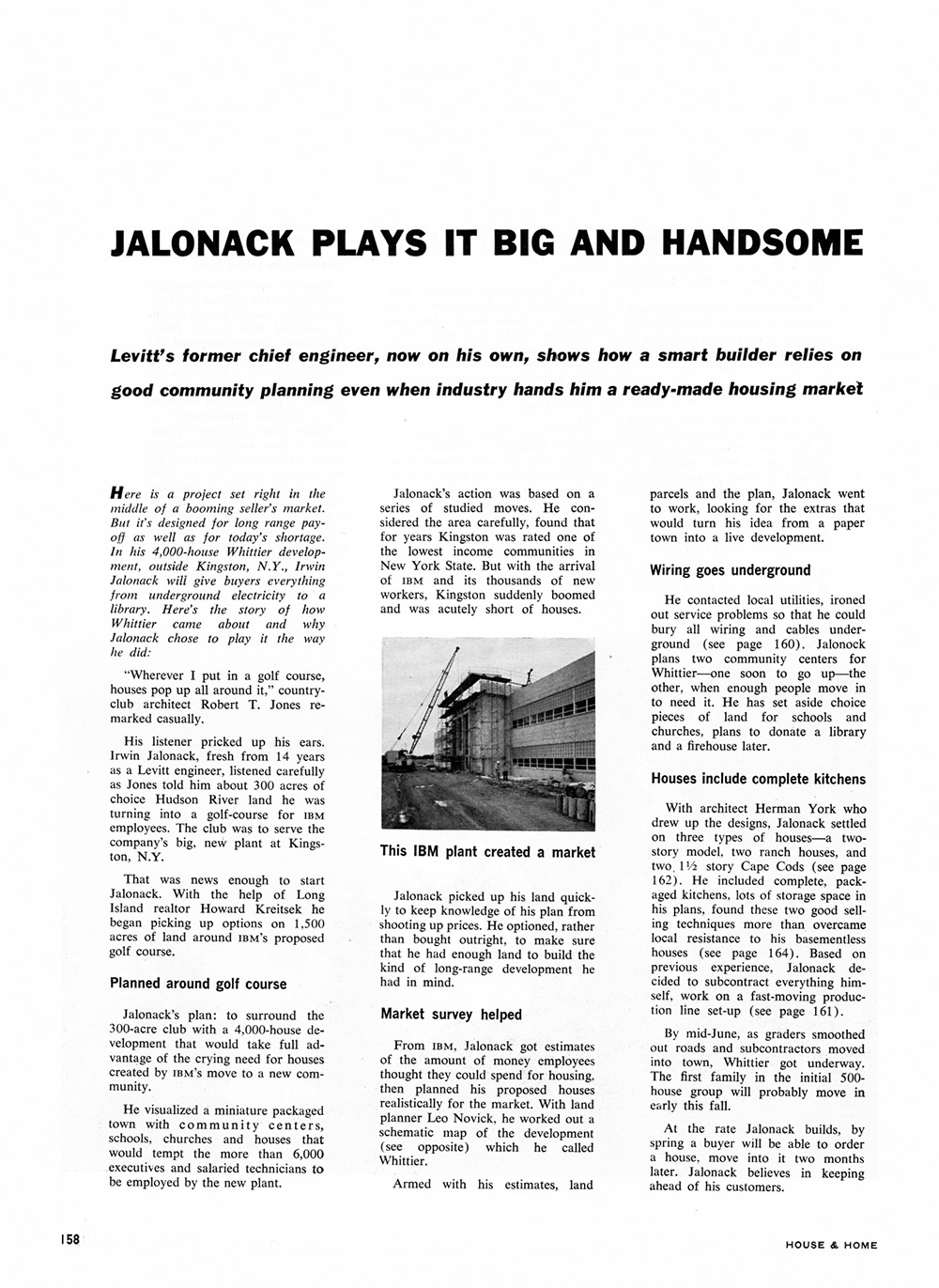


JALONACK PLAYS IT BIG AND HANDSOME
Levitt's former chief engineer, now on his own, shows how a smart builder relies on good community planning even when industry hands him a ready-made housing market
Here is a project set right in the middle of a booming seller's market. But it's designed for long range payoff as well as for today's shortage. In his 4,000-house Whittier development, outside Kingston, N.Y., Irwin Jalonack will give buyers everything from underground electricity to a library. Here's the story of how Whittier came about and why Jalonack chose to play it the way he did:
"Wherever I put in a golf course, houses pop up all around it,"ù country-club architect Robert T. Jones remarked casually.
His listener pricked up his ears. Irwin Jalonack, fresh from 14 years as a Levitt engineer, listened carefully as Jones told him about 300 acres of choice Hudson River land he was turning into a golf-course for ibm employees. The club was to serve the company's big, new plant at Kingston, N.Y.
That was news enough to start Jalonack. With the help of Long Island realtor Howard Kreitsek he began picking up options on 1,500 acres of land around ibm's proposed golf course.
Planned around golf course
Jalonack's plan: to surround the 300-acre club with a 4,000-house development that would take full advantage of the crying need for houses created by ibm's move to a new community.
He visualized a miniature packaged town with community centers, schools, churches and houses that would tempt the more than 6,000 executives and salaried technicians to be employed by the new plant.
Jalonack's action was based on a series of studied moves. He considered the area carefully, found that for years Kingston was rated one of the lowest income communities in New York State. But with the arrival of ibm and its thousands of new workers, Kingston suddenly boomed and was acutely short of houses.
Jalonack picked up his land quickly to keep knowledge of his plan from shooting up prices. He optioned, rather than bought outright, to make sure that he had enough land to build the kind of long-range development he had in mind.
Market survey helped
From ibm, Jalonack got estimates of the amount of money employees thought they could spend for housing, then planned his proposed houses realistically for the market. With land planner L‚Öúo Novick, he worked out a schematic map of the development (see opposite) which he called Whittier.
Armed with his estimates, land
parcels and the plan, Jalonack went to work, looking for the extras that would turn his idea from a paper town into a live development.
Wiring goes underground
He contacted local utilities, ironed out service problems so that he could bury all wiring and cables underground (see page 160). Jalonock plans two community centers for Whittier one soon to go up the other, when enough people move in to need it. He has set aside choice pieces of land for schools and churches, plans to donate a library and a firehouse later.
Houses include complete kitchens
With architect Herman York who drew up the designs, Jalonack settled on three types of house-îa two-story model, two ranch houses, and two. l¬Ω story Cape Cods (see page 162). He included complete, packaged kitchens, lots of storage space in his plans, found these two good selling techniques more than overcame local resistance to his basementless houses (see page 164). Based on previous experience, Jalonack decided to subcontract everything himself, work on a fast-moving production line set-up (see page 161).
By mid-June, as graders smoothed out roads and subcontractors moved into town, Whittier got underway. The first family in the initial 500-house group will probably move in early this fall.
At the rate Jalonack builds, by spring a buyer will be able to order a house, move into it two months later. Jalonack believes in keeping ahead of his customers.